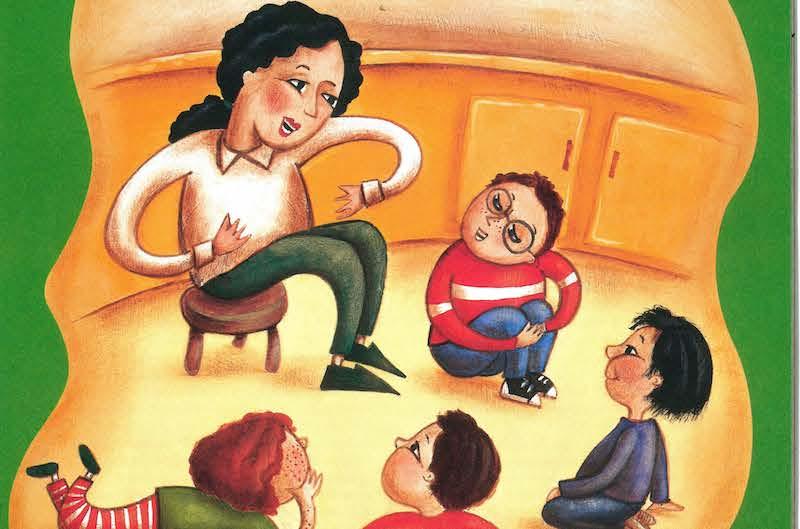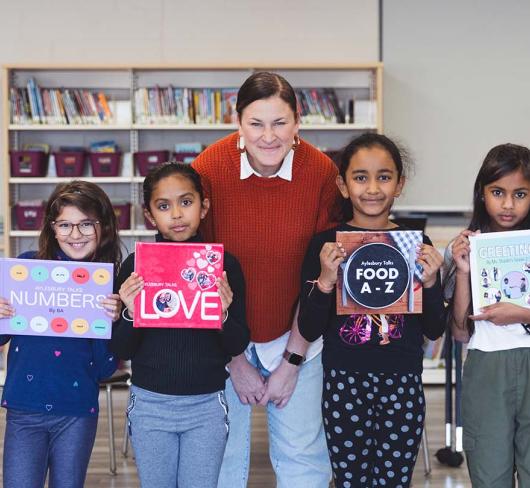
The Telling Bee
"Use your Bingo Voice," the teacher said, as the child tried to tell her story. We were in a kindergarten room doing a Telling Bee, and the five-year-old, eyes downcast, was shyly whispering her story to the class. Your bingo voice, the teacher explained to me later, is the one you use when you get the right number and call out your triumphant BINGO! for all to hear. With the teacher’s encouragement, the child was a storyteller transformed. The shyness dropped away as she thrilled us with her spirited tale telling. Eventually, every child in the school, every teacher, the office staff, the administrators, and the caretakers lifted their voices and shared their stories.
I first had the idea for the Telling Bee after visiting countless Young Authors’ Days. I noticed that many of the grade 5 boys wrote stories that featured aliens, horror and various exploding things. The girls tended to write about surfers named Chad who saved girls on the beach. TV stuff, and much of it as fiat as the screen it came from. These same students, however, told me marvellous stories if I asked the right questions. What were you famous for as a baby? What did your grandparents do when they were your age? How did your family come to this part of Canada? Have you ever met a true-life hero in your own family? Those questions unlocked truly fascinating stories.
I also noticed that when children shared family lore, it built a strong sense of community in the class. They realized they shared a common culture, that every family had its share of joy and trouble, that every person had a story to tell. The children found such stories far more interesting than phony stuff about laser weapons and surfers named Chad. I decided to create a curriculum unit that would bring the values and skills of storytelling into classes, libraries and whole schools.
First you listen ...
I did the first Telling Bee - named after such neighbourly events as quilting bees, barnraising bees and, yes, spelling bees - at my own children’s school, McMurrich Public School, Toronto.
As I presented the idea, a Portuguese boy told me a proverb that was to become the motto of the Telling Bee: “First you listen, then you talk.” You begin by listening to the storytellers in your life; then you bring those stories back to share with the class.
The children at McMurrich began by collecting stories from parents, grandparents and neighbours. They brought back hundreds of incredible real-life experiences, and several traditional folktales and fables. For many weeks the community buzzed with the sound of storytelling. To safeguard the privacy of the families, I emphasized that the children had to have permission to re-tell the stories they’d collected.
The Talking Stick
To help them tell their stories, I introduced the custom of the “talking stick.” I carry a special stick that was given to me by an Anishnabe storyteller. The custom is that whoever holds the talking stick has the attention and respect of the community. We even have a version of the talking stick in Parliament, called the Speaker’s mace. I like this element of ritual because it helps shy students stand up and share their stories. It’s also a challenge for each class to create its own distinctive stick.
After everyone had told their stories, they wrote them down. Kindergarten students and some ESL students needed the teacher’s special help to get their stories on the page. Finally, we brought all of the stories together and made a book, which was launched at a wonderful party at the school. The book has since been through three printings.
I’ll never forget the elderly woman who came up to me, her eyes shining with pride, and said, “You have read the story about the girl during the Greek civil war? My granddaughter wrote that story down. The girl in the story was me!”
As the students heard each other’s stories, and then read the book, the talk in the schoolyard began to include the new awareness brought by the stories. The students were amazed by the romantic war story told by the gym teacher. They learned how a boy had got his burn scars. They laughed at the poem the caretaker contributed. The grade 6 teacher learned that one of his students had escaped from Kuwait during the Gulf War, and her story drew forth his own, about a friend who’d lost his wife and daughter in Auschwitz.
Vivian Gussin Paley, writing about storytelling in her work with preschoolers, said, “You must invent your own literature if you are to connect your ideas to the ideas of others” (Paley, 1990).
At McMurrich Public School, I saw the power of storytelling to make a literature that indeed connected the students, staff and community.
Create your own buzz
The Telling Bee format hasn’t changed much since the pilot project. I’ve now helped run more than 30 bees throughout Ontario. Teachers find it ties very well into the curriculum. Children learn skills in oral language, writing, editing and publishing. They develop inter-cultural and intergenerational awareness. They enjoy creating a storytelling environment in the class and connecting their “ideas to the ideas of others” through shared stories.
Here’s how you can do a Telling Bee, either in your own classroom or as part of a school-wide project.
Begin with a talking stick. Be creative. Each child can add something to make it special. Explain that it is a custom found around the world and that the one who holds it deserves the respect of the tribe, class and community. When I visit schools, I always tell traditional folk and fairy tales as well as encourage the collecting of family lore. Heroism, danger, risk taking, humour, resourcefulness, loss: these values are found in our personal lives and heritage, and in the great folktales of the world. A Telling Bee should always include some visits to the Folk and Fairy Tales section of the library. There, children can discover that the art of storytelling has a long and rich tradition.
The students’ first homework is to hunt and gather stories from home. Who are their family’s storytellers? Each family seems to have one or two people who remember the history of the clan. Brainstorm a list of questions the children can ask to unlock some of these stories.
To help kindergarten students participate, I suggest they tell whatever stories they want, rather than something they’ve heard from somebody else. It’s a good idea to send a letter home assuring parents no stories will be told or published without their permission. This letter asks parents to help their children by sharing whatever stories they feel are appropriate.
Over the next few weeks, set aside a regular time to pass the Talking Stick and share stories. The bee works best when students know they’ll be telling on a certain day. Each teacher tailors the storytelling sessions to fit his or her own schedule. Remember! Storytelling is something you get better at the more you do. Students should be able to tell more than once during a Telling Bee.
After the oral phase of the project, have the students write down their stories. If the children aren’t able to write, help them to get the stories on the page. The story should include not only the child’s name but also the name of the person who told them the story. These final drafts are taken home for a parent’s initials.
Publication by committee
If the Telling Bee has been done with the whole school, now’s the time for the Book Committee to take over. Making a book that contains hundreds of stories is a lot of work. The stories must be input; the book must be designed and printed. Every school that has done a Telling Bee has approached the book phase in their own way.
Some schools have a parent committee that does the work; others rely on school staff to prepare the book. When it is finally printed, have a great party and launch the book with all the honour it deserves! A book of stories that reflects the traditions, cultures and values of the whole community is certainly worth celebrating.
At McMurrich, the Principal told a story I always remember when I explain what the Telling Bee is all about. Here, with Mel Beyea’s permission, is the story he called The Blanket: The house was very crowded. Grandpa was getting on his son’s nerves. Grandpa did nothing but eat, sleep and complain. To his son he was a nuisance. The son decided that his father must move away and live somewhere else. Soon the day came. The son decided to give his father half a blanket. The son’s wife pleaded that grandpa should be given a whole blanket. The son insisted that it be half a blanket.
They quarreled. Finally the son agreed to give his father a whole blanket. “N o !” said his son. “Give grandpa half a blanket. I will need the other half, father, to give to you on the day I decide you must move away and live somewhere else.” Grandpa stayed. (Mel Beyea, heard from his grandmother Lottie Mae Taylor.)
That story reminds us that the young take care of their elders just as much as we care for them. Without their listening and remembering, all of our stories would be lost. Without their listening, our voices would have no purpose.
If you’d like to become a Telling Beekeeper, or share any experiences you’ve had with storytelling, please get in touch. And I hope you and your students make an unforgettable Talking Stick!
Dan Yashinsky is a founder o f the Storytellers School of Toronto. His email address is: dan_yashinsky@tvo.org The Storytellers School o f Toronto publishes The Storytellers Directory for Ontario, which lists storytellers working in all parts o f Ontario. To order a Directory call 416-656-2445, or check the website: www.web.net/~storytel. You can join the School for $40/year and receive Pippin * (the newsletter) and Appleseed Quarterly (the Canadian Journal of Storytelling).
Dan's books include the Canadian Storytelling Trilogy, published by Ragweed Press; Next Teller - A Book of Canadian Storytelling; Ghostwise - A Book of Midnight Stories; At the Edge - A Book of Risky Stories. These collections include more than a hundred stories being told across Canada, representing many cultural traditions and styles o f storytelling.
Also recommended: anything by Bob Barton, Cathy Miyata, David Booth, Celia Lottridge, Alice Kane, Robert Munsch or Joan Bodger. These are some of our great storytelling advocates and creators. Every school library should have their work available as a resource for teachers bringing storytelling into the classroom.
Reference
Paley, Vivian Gussin. The boy who would be a helicopter. Harvard: 1990.

